[Guide] Activating your SMS Proxy virtual number

Since the launch of our SMS Proxy (beta) service earlier this year, there has been a sharp increase of new users wanting to give texting a shot. To most, the introduction of secure SMS texting is a critical step towards better business communication. Today, we’ll explore how to sign up and activate our SMS proxy virtual number. Signing up for the service is super easy if you are already a client, or a partner. For new clients, please contact our sales team to get started. (Don’t worry, the signup is also quick and easy.)
What’s SMS Proxy?
ExchangeDefender SMS Proxy is a virtual number that delivers SMS/TXT messages to your phone, email, Slack, or Teams. This service is currently available for local numbers in United States, Canada, United Kingdom, and Australia.
Signing up
Currently, ExchangeDefender SMS Proxy is currently only available to IT Solution Providers through the ExchangeDefender Partner Program. Once you’re in our free partner program, you will have access to our portal that is used for service orders, management, support, and everything else you’ll need. For businesses who would like to sign up but do not have a service provider, please contact our sales team.
Activating our SMS Proxy service only takes a few minutes, and does not require any downloads or installations. Here’s how to get your very own virtual number with ExchangeDefender:
Step 1 – Login to https://support.exchangedefender.com
Step 2 – In your side bar, click on the Service Manager tab, then select the SMS Proxy option.
Step 3 – To reserve your number, first choose which country you would like your virtual number to originate from. You’ll want to click on the input box to select your country.
Step 4 – After you choose your location, you’ll be asked to choose your preferred number from a set of displayed options. Select the number that you would like to be your new virtual number.
Step 5 – Last step, click on the Setup ExchangeDefender SMS Proxy button to activate your number!
Congratulations, you’ve signed up for your first ExchangeDefender SMS Proxy virtual numbers. You can terminate it at any time. You can also purchase as many numbers as you want (many people use separate numbers for staff, teams, alerts, or seasonal promotions).
For more information on our SMS Proxy service, click here.
Click SMS Proxy documentation to get a more detailed guide with screenshots.
5 ExchangeDefender services that are currently free

Today we wanted share with you our top five free services that ExchangeDefender currently offers to active users. The key word is “active users”, a user must already be using ExchangeDefender to be able to enjoy these additional free options. This is true for all the services mentioned below, with one exception – Wrkoo. Alright, now that we’ve mentioned the fine print, let’s talk about these complimentary services.
Wrkoo – Client support software
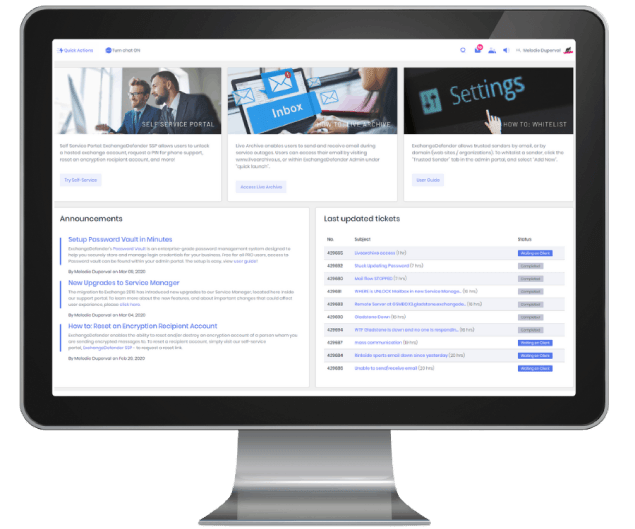
Wrkoo is a small business management software that manages all of your daily business activities in one place. It is mainly used by B2B companies that provide a service or product. However, with the rise of online eCommerce, customer support software, or support ticketing systems has increased. WRKOO streamlines your client’s interactions. The all-inclusive Helpdesk software is easy-to-use. Thus, providing all the right tools to quickly resolve small business’ budget restraints. You can signup for Wrkoo absolutely free, get started right now!
Password Vault – Encrypted password manager
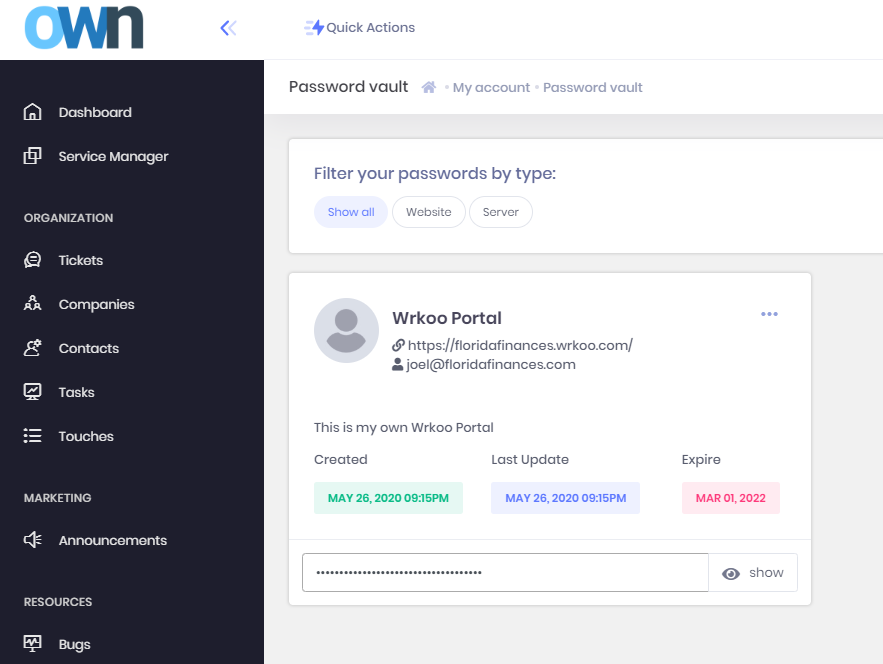
ExchangeDefender Password Vault makes generating, storing, and sharing passwords easy and safe. It features military-grade encryption, unlimited entries, and role-based access controls. The feature is extremely secure and reliable with AES-256 bit encryption. Forgot your password? A password manager eliminates password fatigue as well as memorizing multiple passwords. Here’s some information that is good to know – 1) It’s free only to ExchangeDefender PRO user, 2) It uses the same credentials as the admin portal, 3) and it meets security and regulatory compliance for SOX, HIPAA, PCI, and more. Learn how to access and setup the password vault, click here.
ExchangeDefender SMS Relay (Beta)
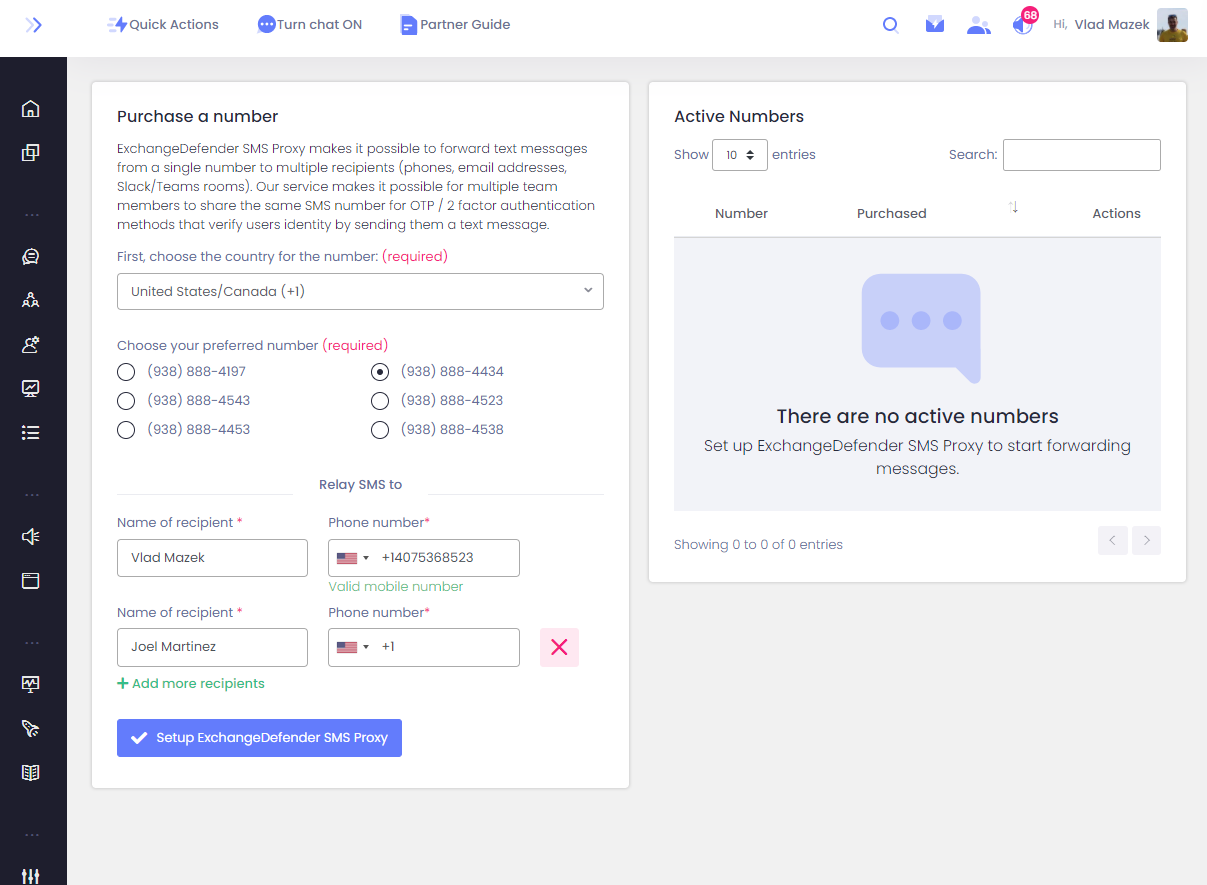
SMS Relay, our text forwarding from ExchangeDefender enables you to share a number – with your team, your family, your entire department – so when all these sites and services need to send you something to your phone to confirm your identity, you don’t have to think about whose phone was used to enroll to the service. How to get started? You can sign up for it in our portal at https://support.exchangedefender.com/sms-relay.php. Just pick a number and add the phone numbers of people you want to get a copy of the message. That’s it. It is currently in beta, and is free – all future users will need to pay just $5 per month for the number, and you can have it forwarded to five cell phones.
Sales and Marketing Collateral
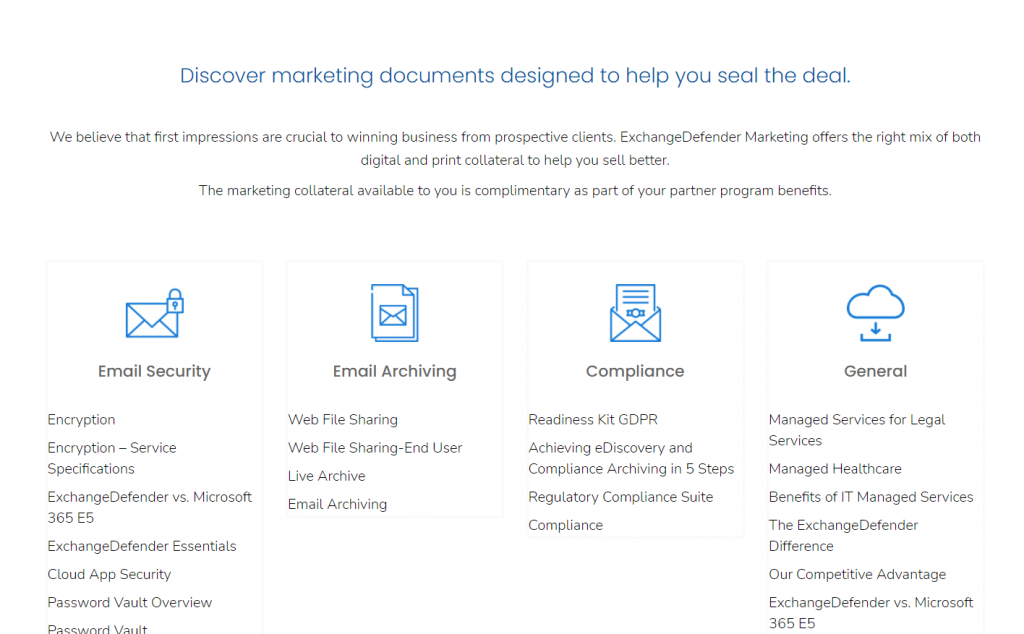
We believe first impressions are crucial to winning business from prospective clients. ExchangeDefender Marketing offers the right mix of both digital and print collateral to help you sell better. The marketing collateral available to you is complimentary as part of your partner program benefits. We currently have a library of sales sheets and brochures for each solution that is available for download. The library is updated several times a year. Be sure to discover our marketing documents designed to help you seal the deal.
Bypass Email Addresses

A bypass email address is a disposable email that is used for specific communication purposes. They are free, simple to setup, mask your real email address, and they bypass all security policies. The system will generate a random disposable email address. Disposable addresses are private and secure. Any mail delivered is automatically redirected to the real address previously selected. This feature is available to all ExchangeDefender Pro clients, setup now with our how-to guide.
Partner reviews wanted, get $5 credit

ExchangeDefender is looking for current partners who are enjoying their partnership with us. For those whom are willing to submit a positive review, we are offering a $5 credit on your next monthly service bill.
How we’ll use your review
Your reviews would be used for internal and public use. On the inside, we’ll be using your experiences to better shape our partner program. Hearing thoughts coming directly from our active service providers is golden for us. In terms of public use, we would like to use your reviews, along with your MSP company name on our website and social media.
Interested? Here’s what we’ll need:
– at least 45 words in length
– add Company name
– add # years you’ve been with us (estimates are cool too)
– submit a ticket inside our support portal with title “Positive Review”
– Add the review inside the ticket, and Send!
Once we’ve received your review, you will receive a response to your ticket with a “thank you” and confirmation of the $5 dollars being credited to your account. You will see the credit on the following month’s invoice.
We work hard each day to bring you the best service possible. We’d like to thank you in advance for taking the time to leave us a few kind words.
[Explained] Our ‘Regulatory Compliance Suite’ for business

ExchangeDefender’s Regulatory Compliance suite automates GDPR and HIPAA compliance for small business. We help organizations comply with compliance regulations by automating detection of sensitive private information, EU client data, consent tracking and powerful audit & policy wizards that alert you to potential issues.
What makes up the Regulatory Compliance suite?
The suite comprises of two ExchangeDefender solutions bundled together: Email Archiving, and Corporate Encryption. Both solutions are also available a-la-carte as individual services. Let’s first talk about Email Archiving, we call it – Compliance Archive.
Compliance Archive is known for its Corporate Archiving and eDiscovery capabilities. It provides a fast and secure environment to store, process and index your entire mailbox and keep it accessible for up to 10 years. eDiscovery of Sensitive Private Information helps automate your GDPR compliance reports and Data Protection Officer DPR/DPO inquiries.
Noteworthy Compliance Archive features include:
Fast eDiscovery System
Our built-in eDiscovery system makes it easy to search across multiple mailboxes to locate any sensitive private information, source or consent.
Secure Long-term Archiving
Compliance Archive gives Compliance Officers access to 10 years of mail, allowing eDiscovery reporting to find sensitive personal information and original consent quickly and easily.
Data Protection
Compliance Archive assures you that none of your messages have ever been tampered with, deleted or otherwise hacked to hide data leaks.
Comprehensive Reporting
Compliance Officer features allow you to save advanced searches, execute them in the background and have consistent discovery month-to-month.
Mail Journaling
Exchange Journaling Technology assures full archiving of all inbound, outbound and internal email.
ExchangeDefender Corporate Encryption
Our advanced data encryption software enables organizations to quickly send and receive encrypted messages by email, url, or sms. It is easy to use, can auto-detect sensitive data, and offers real-time reporting. Corporate Encryption complies with the GDPR, SOX, HIPAA, SEC and local government requirements for information encryption while providing powerful audit and policy management to meet organizations goals.

Noteworthy features for Corporate Encryption
Encrypt Client Data on Demand
Our encryption feature is easy to use requiring no additional software, no configuration, or install. Simply send an email like usual and add [ENCRYPT] in the subject line.
Intercept and Review / Encrypt Sensitive Data
Corporate encryption can automatically encrypt messages or forward the contents to the administrator for the corporate review. Our Strict Encryption [ENCRYPT] has an added layer of security requiring a password and 4-digit pin for secure access.
Automatically Detect Sensitive Private Information
Pattern-based encryption that can detect credit card numbers, social security numbers, dates of birth and other sensitive private information.
Use Message Content Filters To Restrict Sharing
Lexicon dictionaries can contain words and word patterns that indicate someone is sending user data, automating eDiscovery.
Comprehensive Reporting
Comprehensive reporting of all email activity as well as a Compliance Officer (CO) reporting with search capabilities provide proof of regulatory compliance and simplify reporting, audits, discovery and shift liability for message storage, access and destruction.
Interested in ExchangeDefender Compliance Suite? Request a quote.
Managed Service Provider? Become a Partner.
New SMS Proxy service brings texting to business
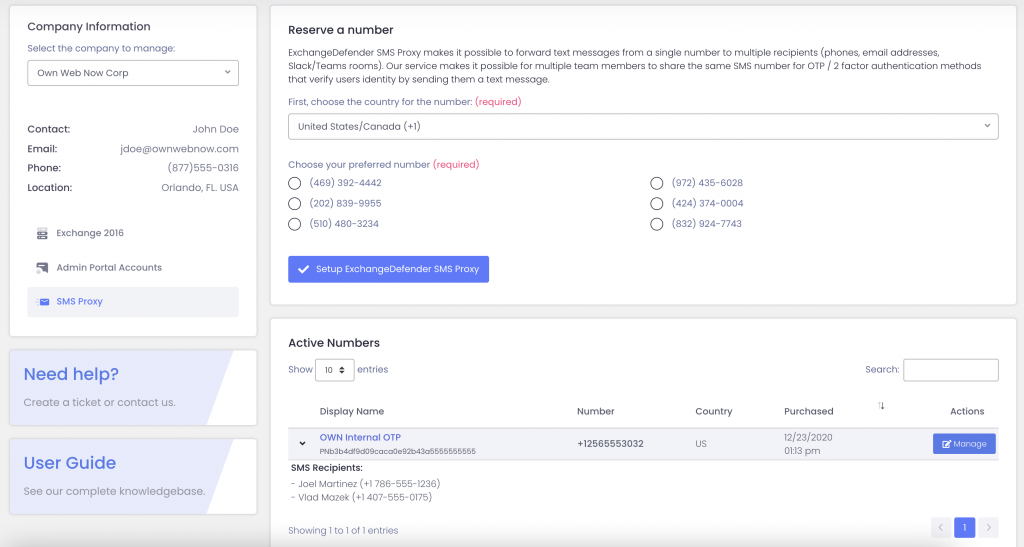
Last Christmas we delivered ExchangeDefender SMS Proxy, a simple virtual number that can forward TXT messages to up to 5 other mobile devices. That beta release has been so wildly successful, all over the world, that three months later we’re using it to solve a much bigger problem:
Integrating client and vendor TXT messages into where your team works: mobile phones, email, Slack, and Microsoft Teams chat rooms.
The disruption that 2020 brought to our lives, businesses, and the way we communicate has been immense. Our mobile phones have become the default place for notifications from everyone we interact with – appointment reminders from every professional service you rely on, your airplane boarding pass, suspicious transaction notifications from your bank, every other web site txting you a short code to verify your identity – everyone is texting. Your business should too.
ExchangeDefender SMS Proxy has made that simple. No more relying on the lone “office cell phone” that multiple people share but nobody charges. No more hoping that some hack job of web services that someone setup years ago continues to work. No more worrying about legal implications – with no archiving, access, or supervision.
ExchangeDefender SMS Proxy answers all of those questions and does so for far less than a cost of monthly cell service. We also stand behind it with a full SLA and 24/7 support. Most importantly, we reliably deliver messages to where your staff is already working – be it a phone, email, Slack, or Microsoft teams.
Interested? Contact us today to get started! Learn more about ExchangeDefender SMS Proxy.
Signup for our ExchangeDefender SMS Proxy Webinar to get the full feature showcase of the new texting service! The event is scheduled for April, 13 2021 at 12:00pm EST.
How to expand your MSP service offerings

One of the biggest challenges that MSPs are currently facing right now is knowing what to offer (in terms of services) and how to offer it. Due to the pandemic, the business landscape is tricky, and has forced all professional businesses to really look at their services/products and to find a way to reinvent them.
Today, we’ll explore a few ways that could help your MSP business flourish during hard times. The key here is to be resilient, and to create the best conceivable plan for success that will overcome current obstacles.
1. Add more to your current service offerings
The most valuable data you have on your business, is what you currently offer in terms of services. Ask yourself, what do I offer? and What could I be offering now? The most in-demand solutions for our particular industry as MSPs are email security, backup, compliance, and disaster recovery. A great portfolio would showcase an array of solutions that would cover the demand for businesses today. If you offer just security, but not compliance or disaster recovery solutions – research vendors that could help you add these services to your offering (almost instantly).
2. Go bigger with your client size
Sounds like common sense but many MSPs tend to go after companies that are the same size that they are. It’s only natural, but there is a major opportunity for service providers to start making their way into to larger organizations with 50 employees or more. If you already have solid experience with servicing small businesses (25 employees or less), now could be your opportunity to leverage your services to slightly larger organizations. Of course, you will have to think about how to position your business (resources, employees etc) when attempting to attract larger fish. A great way to enter a larger market size is on price, and the ability to offer the best service. Ask your prospective clients, what are they paying now, and perhaps position yourself at a lower price point to land your first larger client.
3. Service Bundles vs. a-la-carte – provide both!
A recent study revealed that 43% of solution providers listed Sales as their biggest challenge this year. Most likely, you are already offering your services a-la-carte, individually. This is a great option for clients who know exactly what they need, or are on a strict budget.
That’s no surprise – but we have a little pro-tip that may help you, as it helped us. Service Bundles are a great way to pitch clients. They offer a clear way to understand the actual cost of services, and the value that they bring. A “bundle” already tells us that there is more than one service included, and that is of great value! What type of service bundles do you currently offer? Here at ExchangeDefender, our individual solutions can be packaged into three distinct packages: Security, Compliance, and Continuity. We looked at all of our clients and determined which services were most popular. Our study showed that for email compliance, our clients were using our Corporate Encryption and our Email Archiving solutions individually. So, we bundled them together and called it a “Compliance Suite”, which automatically raised our revenue, even if by a few dollars per user.
4. Create a sales and marketing plan
Yes, we know – you have heard this a lot, but its true. About 60% of service providers, we surveyed claimed that they did not have overall sales goals, even though they have a solid business plan. It’s important to create brand awareness, to show the world that your company does exist, and has been operating in good-standing since (enter year number here.) Is your website current? Have you created social media profiles for your company? Now is the time to send out company mailers, email newsletters, along with social media ads for facebook, reddit, google – you name it. Here’s a great guide on how to create your own sales and marketing plan.
It sounds like a big money investment, but you control the budget for every aspect. For ads for example, you create your own limits, even if it’s just $5 dollar per day. The same can be said for facebook, youtube, and google ads. Creating your own company social media profiles are free, and so is starting a cool blog for your clients to spread the word.
Download your new ‘Official Partner’ Logo today!
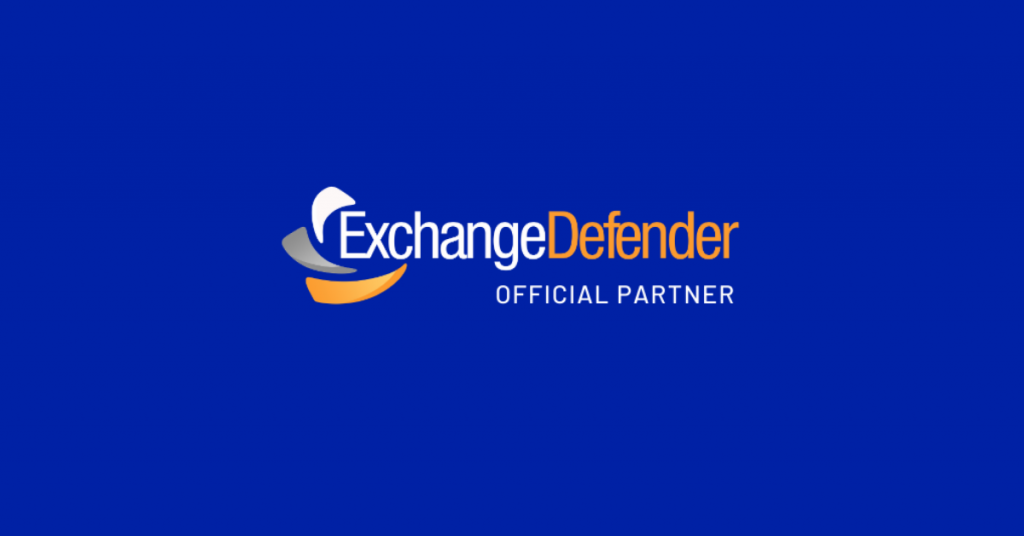
Officially, official.
ExchangeDefender has recently launched an ‘Official Partner’ logo, designed exclusively for our current partners. The logo is a graphic brandmark that features our traditional ExchangeDefender design, as well as the addition of ‘Official Partner’ underneath in dark grey.
There are currently two different versions of the logo to best assist all partners and their individual websites. The option to choose the light, or dark version is totally up to the preference of the partner, (their brand colors, website colors etc.)
Ways to use
We have a few suggestions on how to use your Official Partner logo. The first is on your website. You can download the logo and paste it into your website. Preferably on the front page to show your clients, and prospective clients the current security vendors that you are in partnership. We believe the display of partner logos help express credibility to future clients that you are in good company, and collaborate well with others.
The second option is adding the logo to documents, sale sheets, brochures, invoices – things you would normally give to a potential client. Normally, you would add your company’s logo on the left side, with your partner logo on the right side. Visually its outstanding, and assures the client that you are doing well as an ExchangeDefender business partner, (which you are!).
The third option is using your email footer for when you are emailing back and forth with clients. For example, if you were to look at a company’s signature – you would see the name, title, contact details, as well as any programs, or products that they are currently associated with. The logo is easy to add into outlook or Gmail, and should only take a few mins to complete.
Oh! You can also use the partner logo when making posts on your MSP social media. This could be attached to product specific offerings, or showcasing the third-party vendors that you currently are in partnership.
How to download?
To download is simple.
Below, you’ll find the light version and dark version of the logo. The images are PNG and have transparent background to suit any color. To save, simply right click the image and click save.


Remote-work friendly solutions for business

There is no doubt, the Covid-19 pandemic has completely changed the way that we work today. Daily restrictions of social distancing require all of us to keep our space with many of us still working from home. Despite the current grim reality of 2021, the mobile workforce has been on the rise since before the crisis struck.
It is our jobs as service providers to prepare businesses with solutions that promote secure productivity that is accessible from anywhere. Here at ExchangeDefender, we wanted to share the most popular solutions being sold this year that are remote-work friendly.
Advanced Email Security (ExchangeDefender PRO)
Securing company email is non-negotiable in our digital age, and in 2021 as cyber-attacks have quadrupled in the last year alone. ExchangeDefender Advanced Email Security provides a multi-layered defense against email-borne threats like SPAM, viruses, malware, spoofing, phishing and more. Being honest here, more businesses are asking for our security for our stellar SPAM filtering, and for our advanced phishing and spoofing policies. They are proven to be gold standard in the market right now, most likely because we don’t trust sources easily. Our AI-based email protection provides the strongest defense against spear phishing, account compromise and domain fraud. It offers protection to employees from falling prey to sophisticated email-based attacks.
Web File Sharing
This is our secure file sharing and storage platform that simplifies collaboration in the digital workplace. You can share large files, manage documents, and have unlimited storage for one flat rate. A major benefit is giving your clients access to your file sharing portal to complete transactions together. For security, you can password-protect any file, and control user access to content with expiration dates. Web file sharing makes it easy for teams to share documents without having to rely on email, or old file servers. Of course, Web File Sharing is a regulatory web service and is compliant with all E.U and US regulations.
Live Archive (Email outage protection)
Our rising star as most employees were being sent to work from home, is Live Archive – our email outage protection. It offers interrupted access to live and archive email. It gives businesses an email continuity solution that keeps an organization sending and receiving email without disruption. In plain English, if Gmail or Outlook is experiencing a service outage (which they often do), you would still be able to continue emailing using ExchangeDefender’s live archive. See how it works here!
Corporate Encryption
This was our best-seller last year (in 2020). It was relaunched with advanced encryption options, and became the first of its kind to offer 3 different ways to send a secure message. You can easily send and receive encrypted messages by email, url, or by sms text message. ExchangeDefender Corporate Encryption is easy to use, can auto-detect sensitive data, and offers real-time reporting. Our service integrates easily, and is compatible with all major email service providers – including Office 365, on-premise Exchange, and G-Suite for Business.
If you are an ExchangeDefender partner, we would strongly suggest you to push these remote-work friendly solutions to your clients if you have not already. Our current data shows that the solutions mentioned above have been the most requested from clients since the beginning of 2020. All ExchangeDefender services are available via the cloud, and do not require any downloads or software installations to use. If you are interested in sales and marketing collateral, please submit a ticket request at our support portal – we will have the information to you within 24 hours.
4 growth strategies to expand your MSP business

Every business on the planet is looking for ways to grow, whether you have 2 people on the books, or 2,000. One of the major challenges for MSPs in particular right now is creating and executing a growth strategy. Easier said than done of course, but today we’ll explore a few strategies that will help point you in the right direction.
What is a growth strategy?
A growth strategy can be defined as a special business plan that is created to overcome current or future challenges in order to achieve goals of expansion. Some good examples of growth strategy goals could be: improving your business’ products or services. It could be to acquire new assets like people or resources. Today, we’ll go over the four main growth strategies that companies use in hopes of expansion.
Strategy #1 – Market Penetration
When we talk about market penetration, we are really talking about how well-known a product or service in a particular market. Normally, this is measured by the amount of sales compared to the total market share for that product/service.
What are some examples of market penetration strategy? This could be the raising or lowering of your prices. Often, customers will look for a service that is the best in the market for the lowest price. It is really hard to compete like this, but if you can be competitive (not cheap) with your pricing then you may be able to acquire more customers. Another strategy is defining new target market segments. Let’s say – you’re a service provider, and you’ve only been servicing one type of businesses. You could consider offering your services to other professional businesses that are like-minded, and could use your service.
Strategy #2 – Service / Product Development
The main focus of this tactic is to be creative in how you offer your services. Take a look at your service offerings, could you sell something new? Like develop a new service bundle with your current services, or modify the existing services you offer in a way that would be beneficial for current pain points for businesses. This could be like how we upgraded and completely revamped our Corporate Encryption service. Of course, you could offer your same services but for a new market, as mentioned in the first strategy.
Strategy #3 – Market Expansion
A market expansion strategy focuses on selling current services in a completely new market from where your business currently operates in. For example, a company who operates solely via a partner-channel to sell their services, could start providing their services directly to customers in a direct-to-market strategy. The company is still offering the same services, but is offering them directly, instead via their channel of partners. This usually occurs when growth has peaked in a sales cycle, and the company develops an expansion strategy to overcome their current sales growth challenges.
Strategy #4 – Diversification Strategy
This particular plan is more complex and has at least 5 or 6 different types of diversification strategies. However, we will focus on the most common here, like horizontal diversification. This is when you introduce new services to your current offering in order to expand your market share. Normally a company will license new products, or even merge/acquire another company. Vertical diversification is another popular strategy which focuses on expanding its product line by creating a similar product for the same market. For example, a painting business that provides residential painting services, could start selling their own paint. Same target market (people who need their homes painted), but a new service and opportunity for the painting company to grow by not only painting the homes, but selling the paint itself to paint the homes.
Pro tip from us: Your current clients are your biggest assets. Take a look at what industries they are in, and explore if there are other sectors that could benefit from your services. Like if you currently service law firms, you could also service accountant and financial professionals, right? Secondly, take a look at the services that you are offering. Is there any way that you could expand your service offerings without shelling out too much money upfront? Be sure to compare vendors – their pricing, their fees, solutions offered etc.
Partner with us! Learn more about ExchangeDefender.
Mid-pandemic, resilience is key to business survival

It is crucial for business to reimagine both the labor force and work strategy to be resilient. This include the ability to be flexible, adapt, and respond to change. SMB’s best survival chance is to evolve, execute intentional actions and focus on Resilience being in the forefront.
Adapting the tradition
Traditionally, Efficiency has been a primary focus in most organizations. The pandemic has caused a shift in the way businesses play out their day to day. The primary focus is/was to get the job done faster with inflexible processes that enabled agents to work more competently.
This is not to say efficiency is no longer required but merely has traded places with resiliency. Frankly, corporations must now ensure assets, employees, and their workload are ready to constantly shift with ongoing changes.
Resilience is key
Resilience can be defined as the ability to bounce back after life’s challenges. Businesses who are more resilient have learned to move past obstacles in a healthy way. Resilient people learn and know how to weather the storms that come along in life. They are aware of difficult conditions, can interpret the situation and make sound decisions on what needs to be done.
On the road to resilience – at the onset of the pandemic, companies primarily hoped for the best. They struggle to keep operations running, and are having to furlough or lay off laborers. The main focus at this point for business is financial survival, as COVID-19 continues to devastate our ‘business as usual’.
Well-fed and well-led employees
Companies aggressively protected workers, workplaces, and customers from infections. Also implemented practices to address the core needs of safety and well-being. They focused on being supportive to employees and their families. Cultivated employees to work smarter, by developing new skills and cross-training with other departments thus increasing productivity.
Time to Pivot
SMB’s have accepted, due to the ever-changing market that change is inevitable. Organizations reinvented the hiring process, job design, performance management and pay to coincide with the new operating model. Pivoting toward new markets, services or goods is a great way to build on the foundation a business already has, expands revenue, and brings more income to the organization.
ExchangeDefender provides email security, compliance, and email continuity solutions for small business. To explore our solutions, click here.



